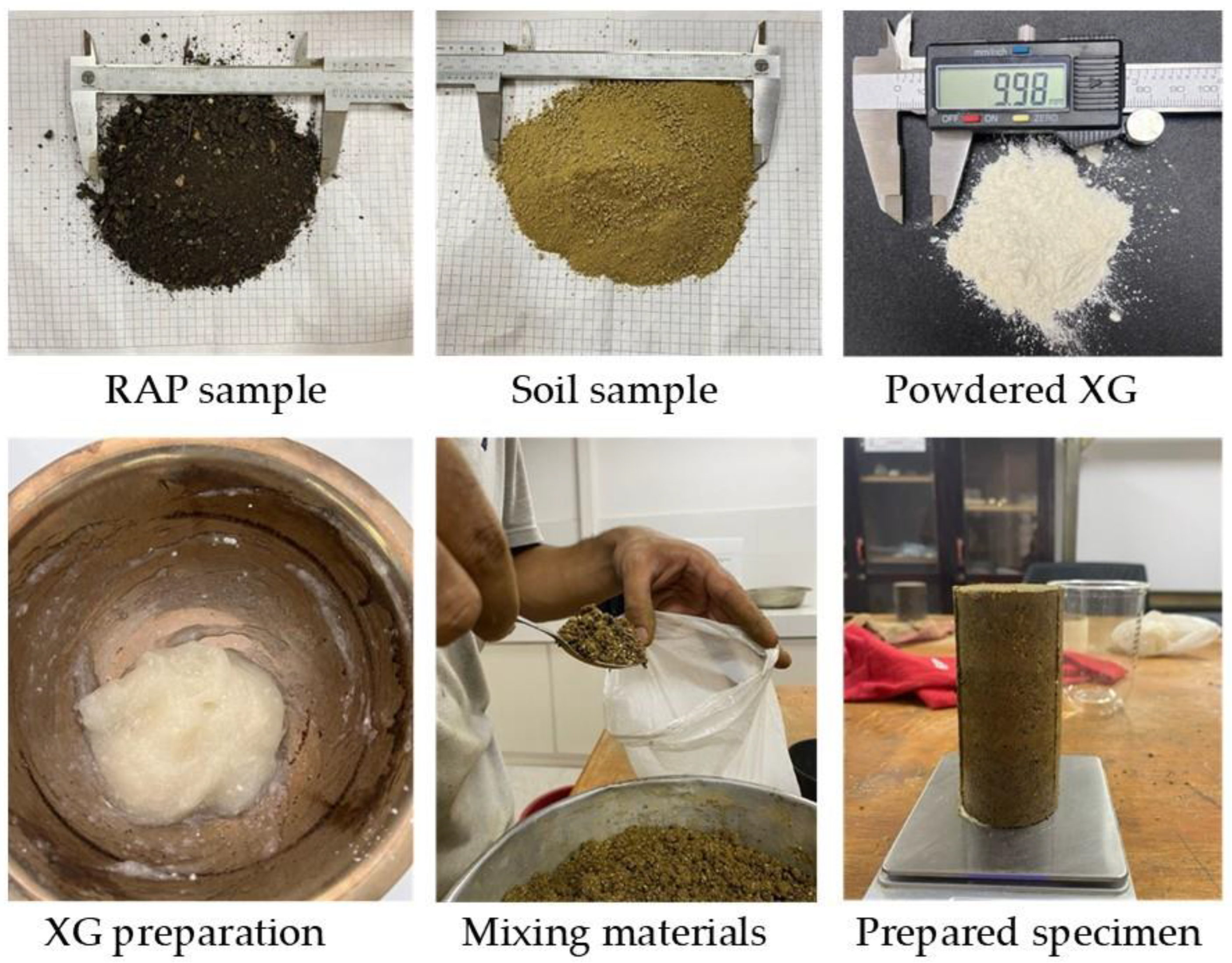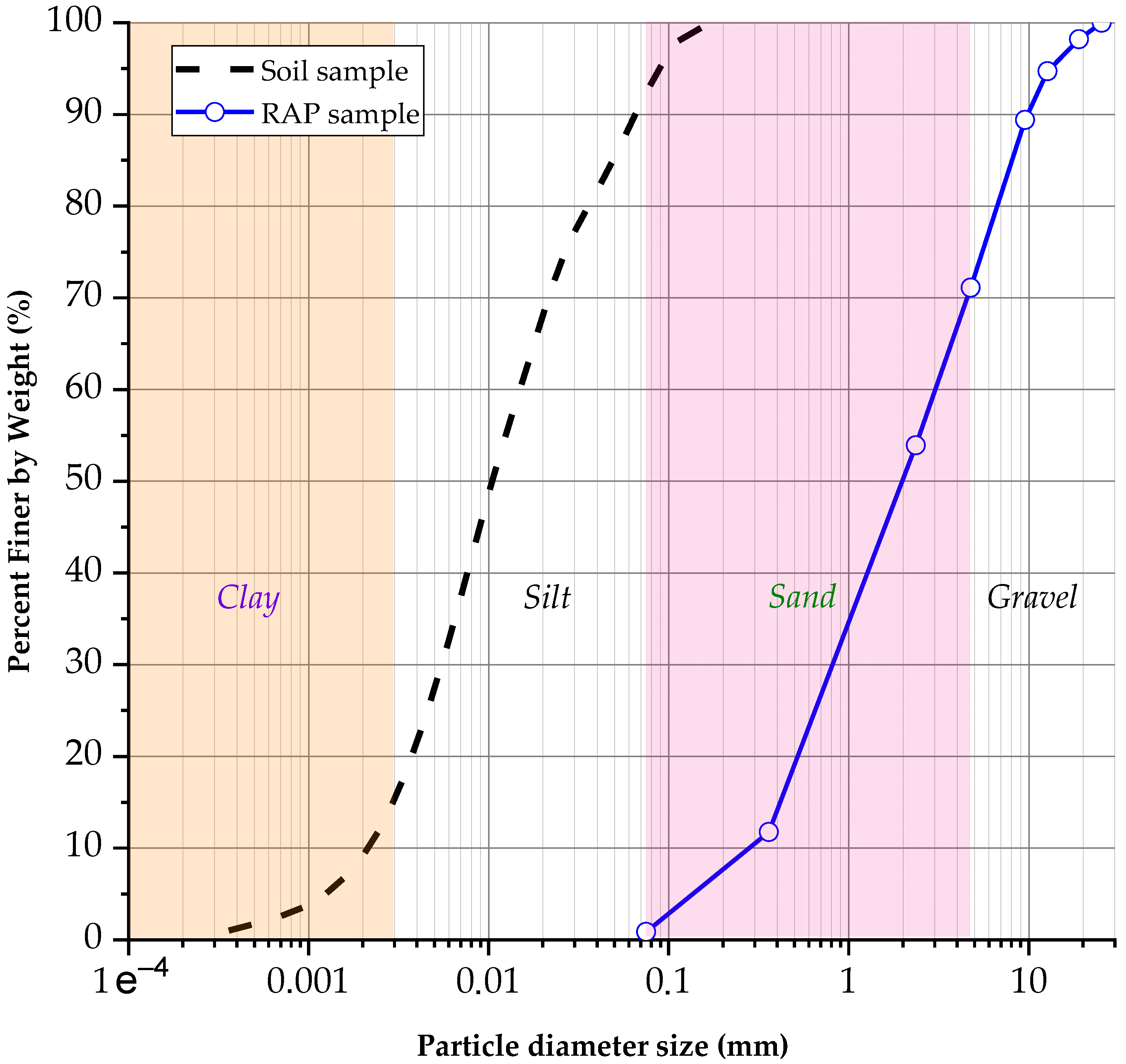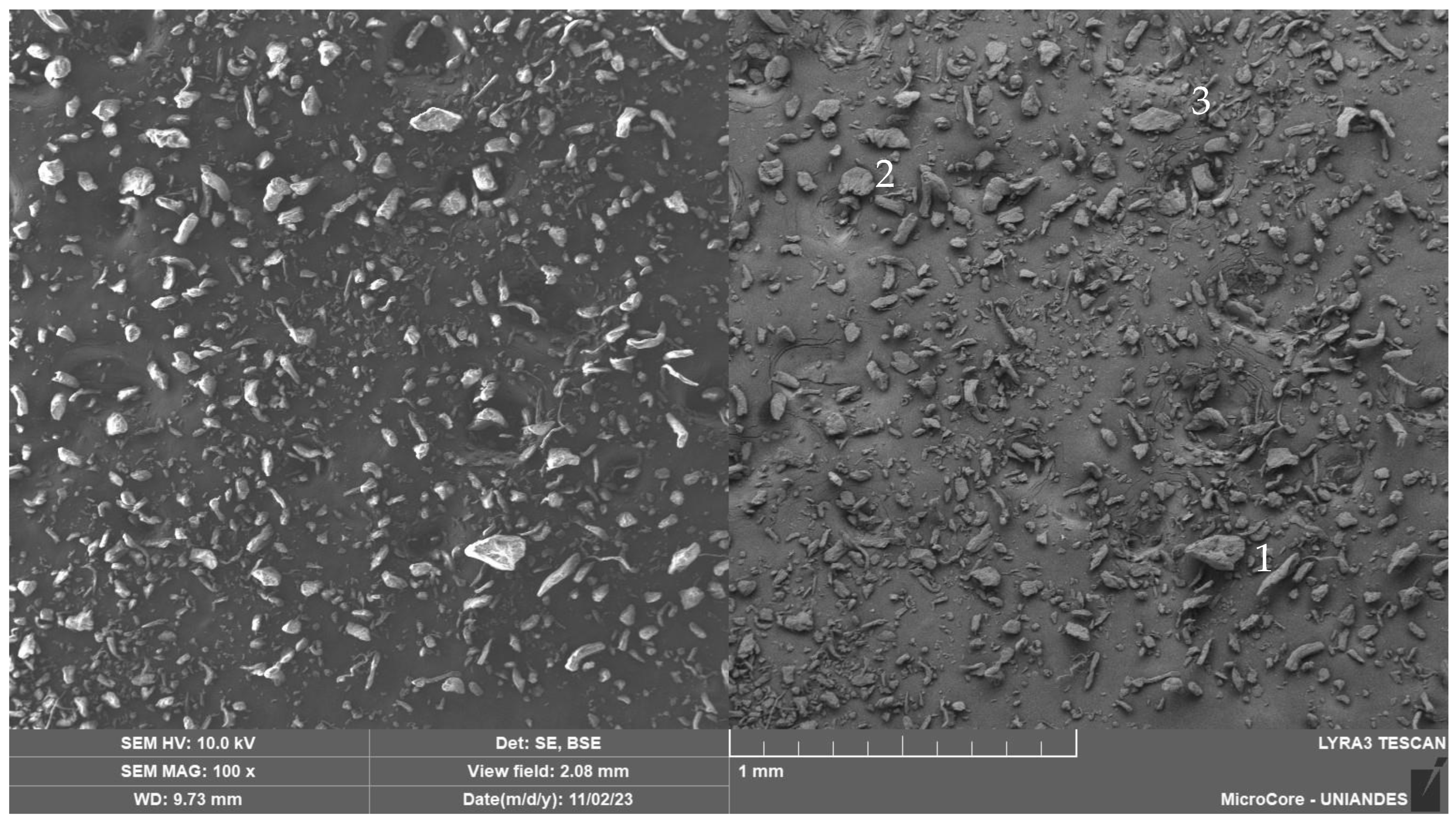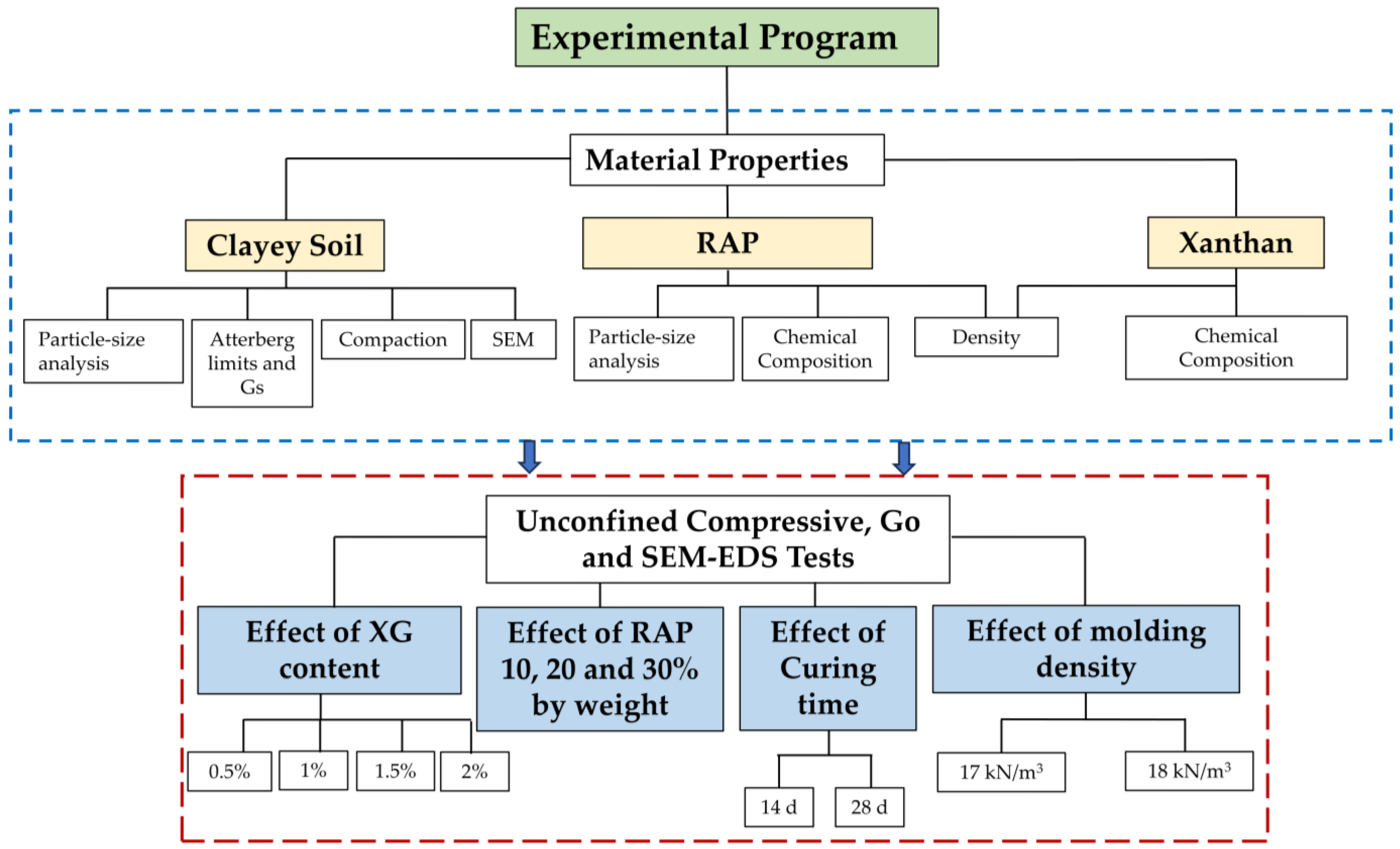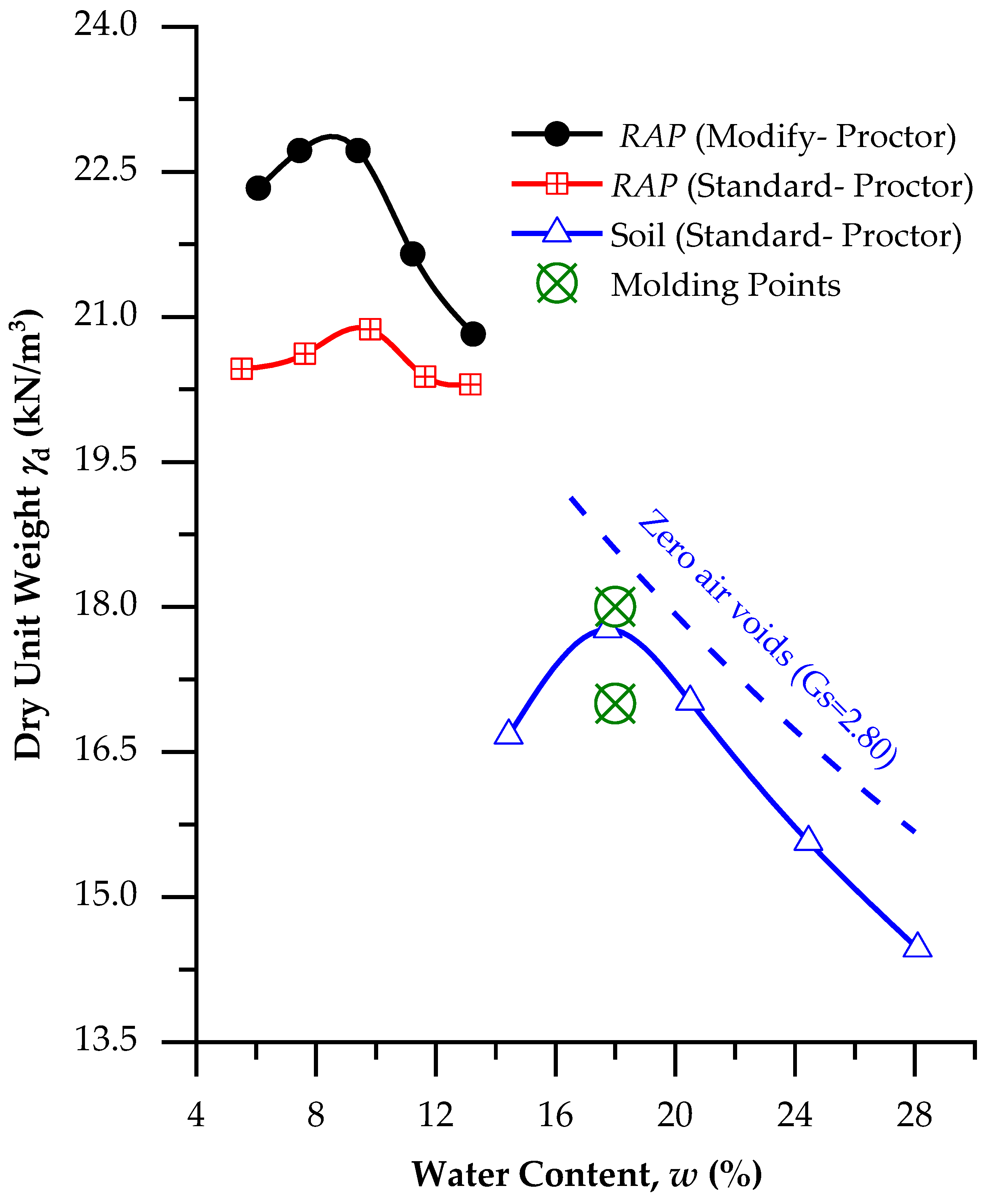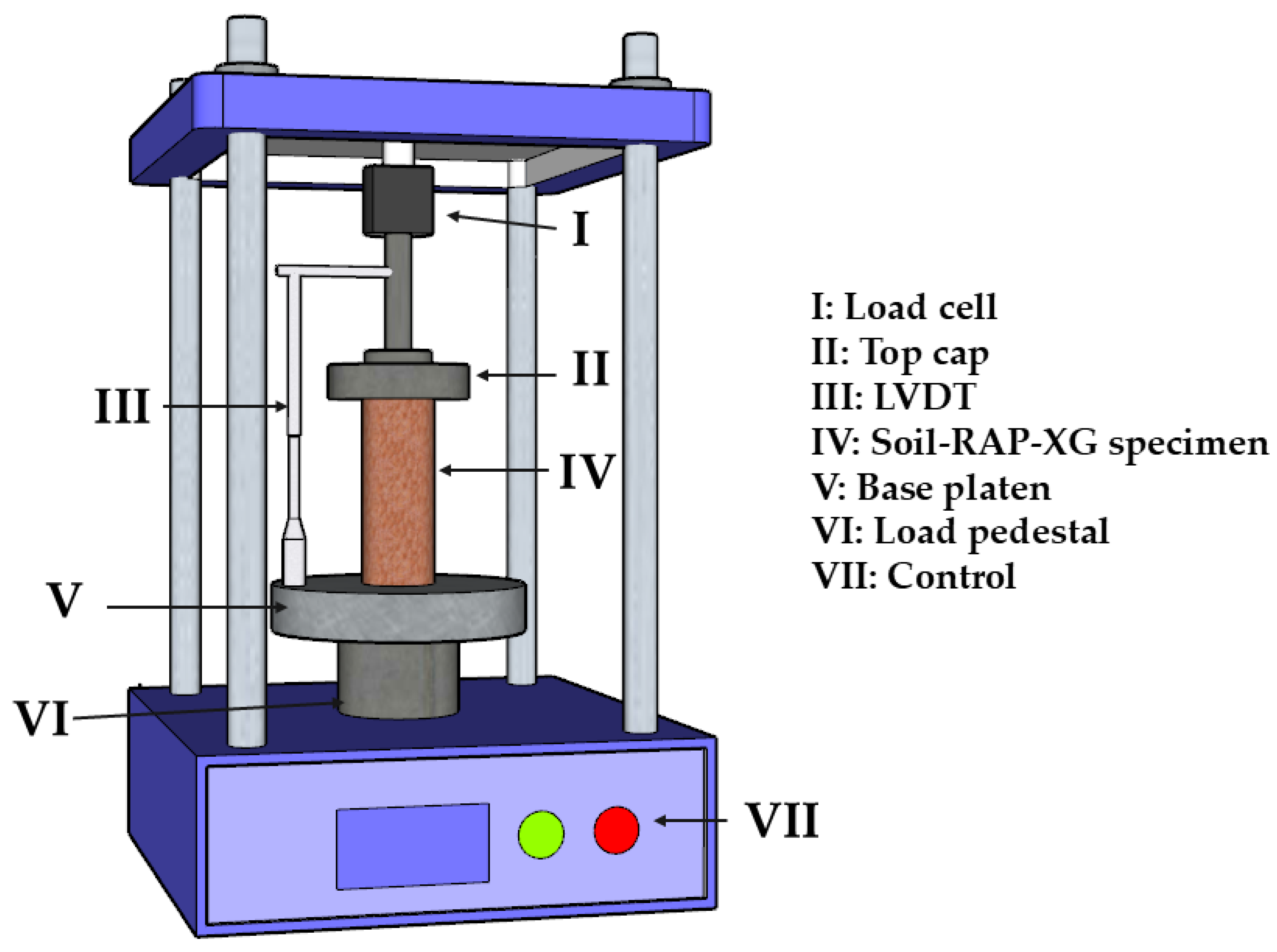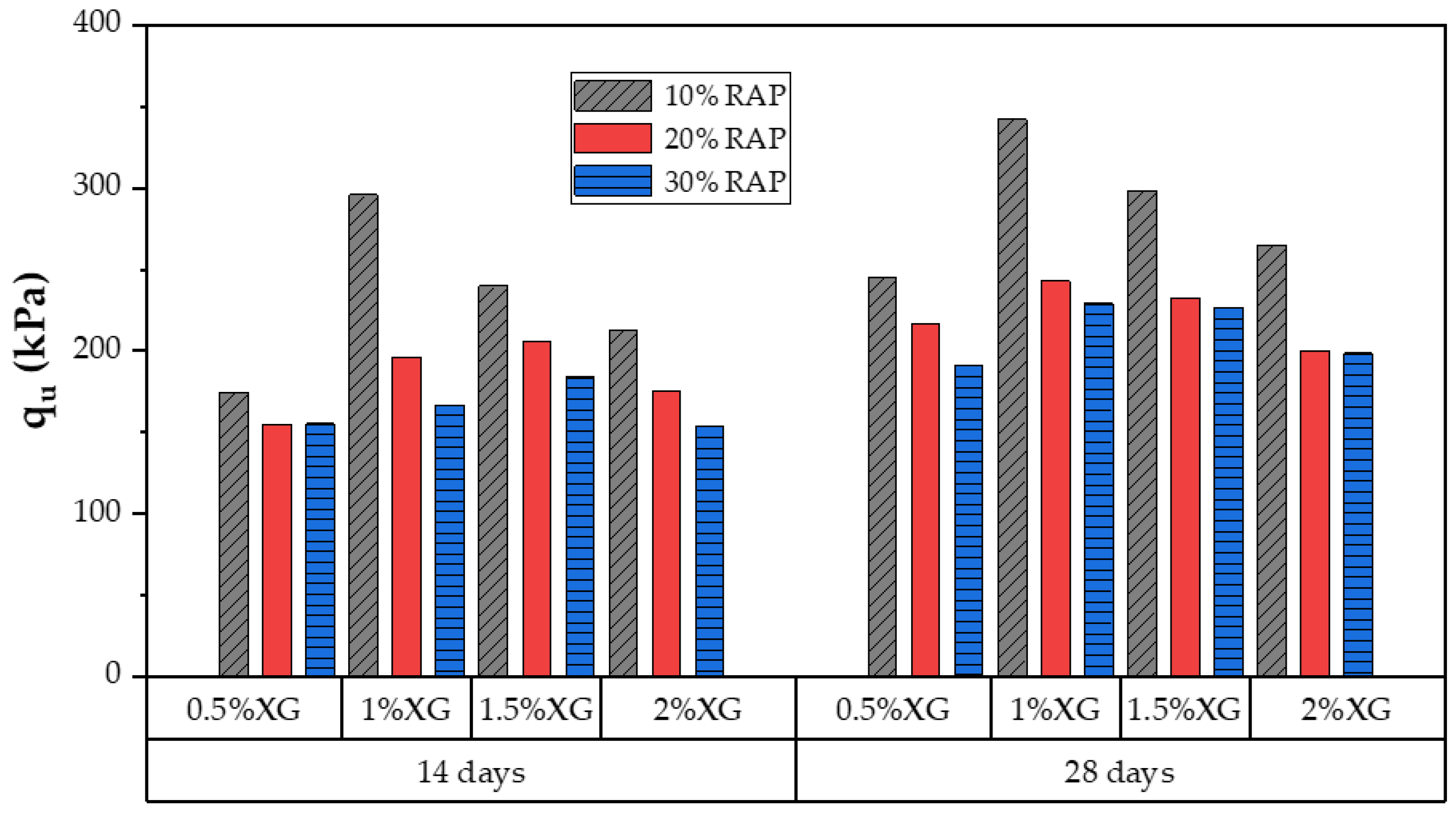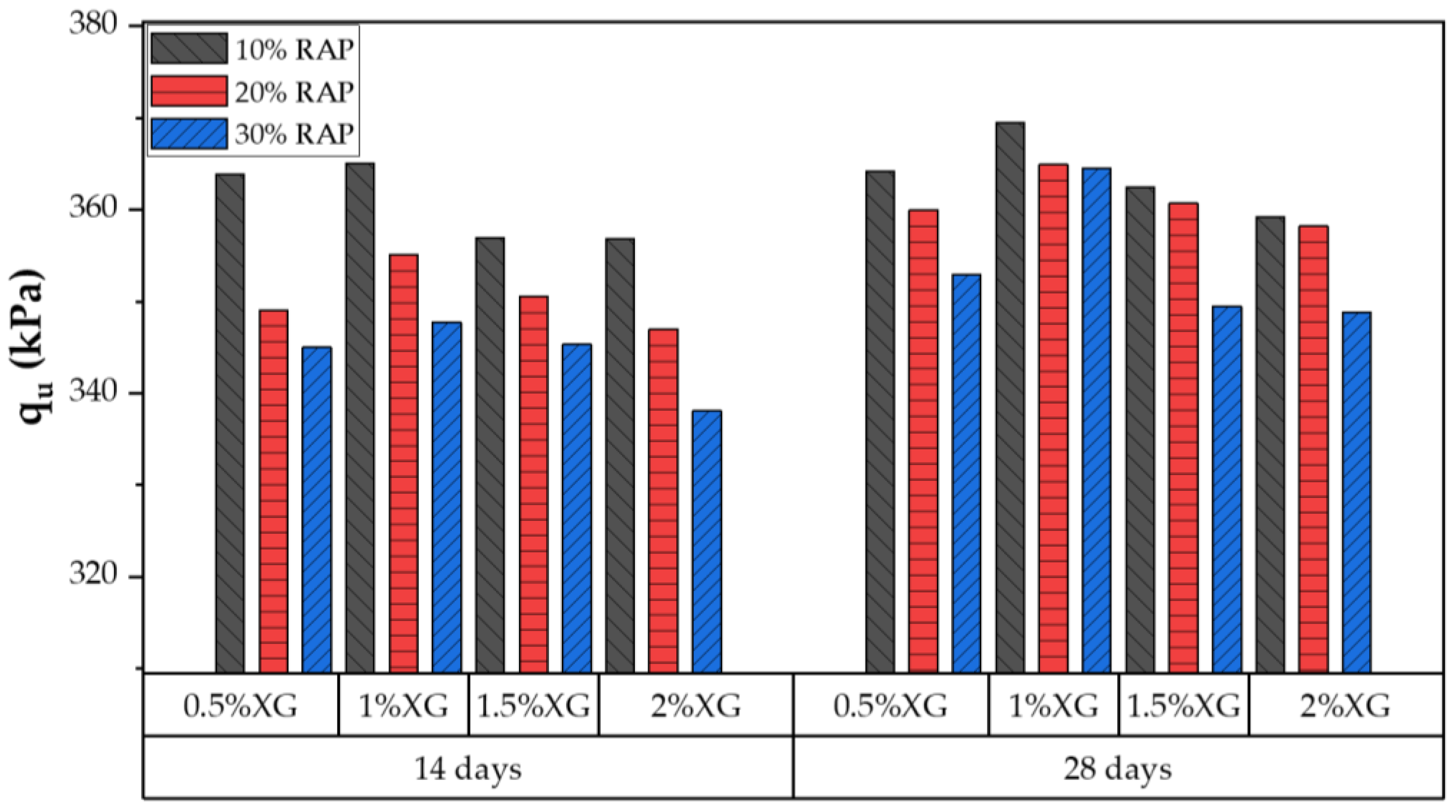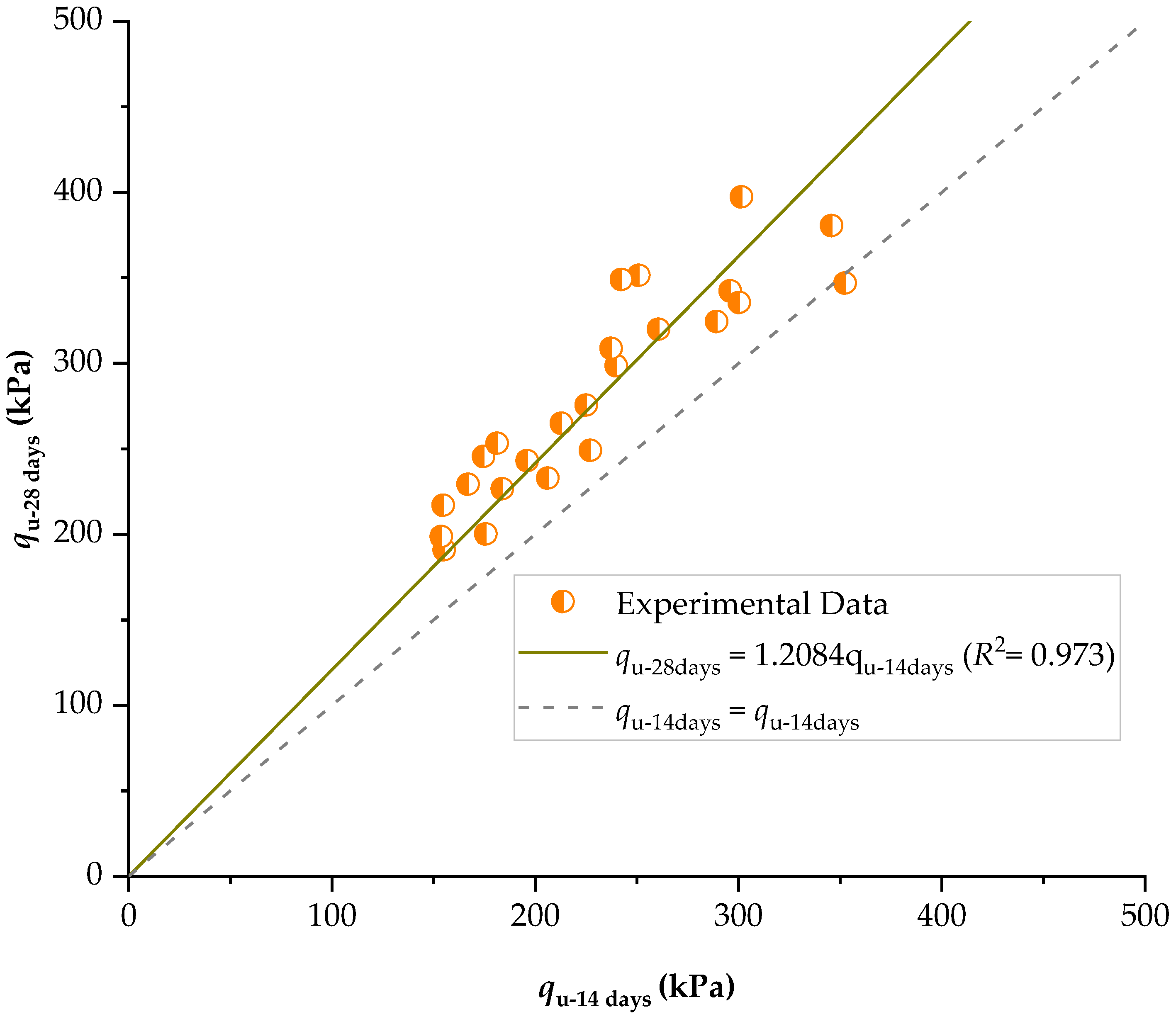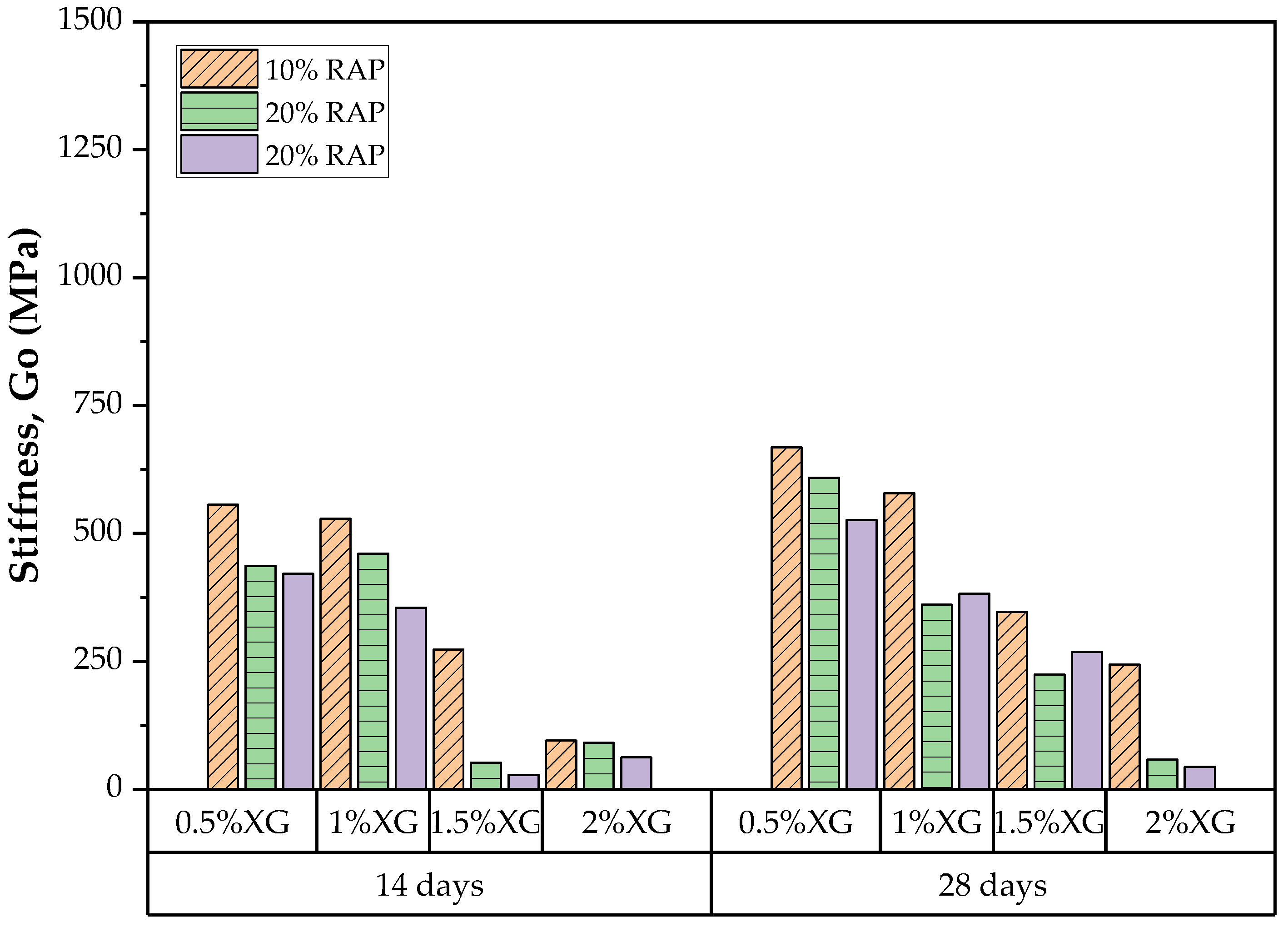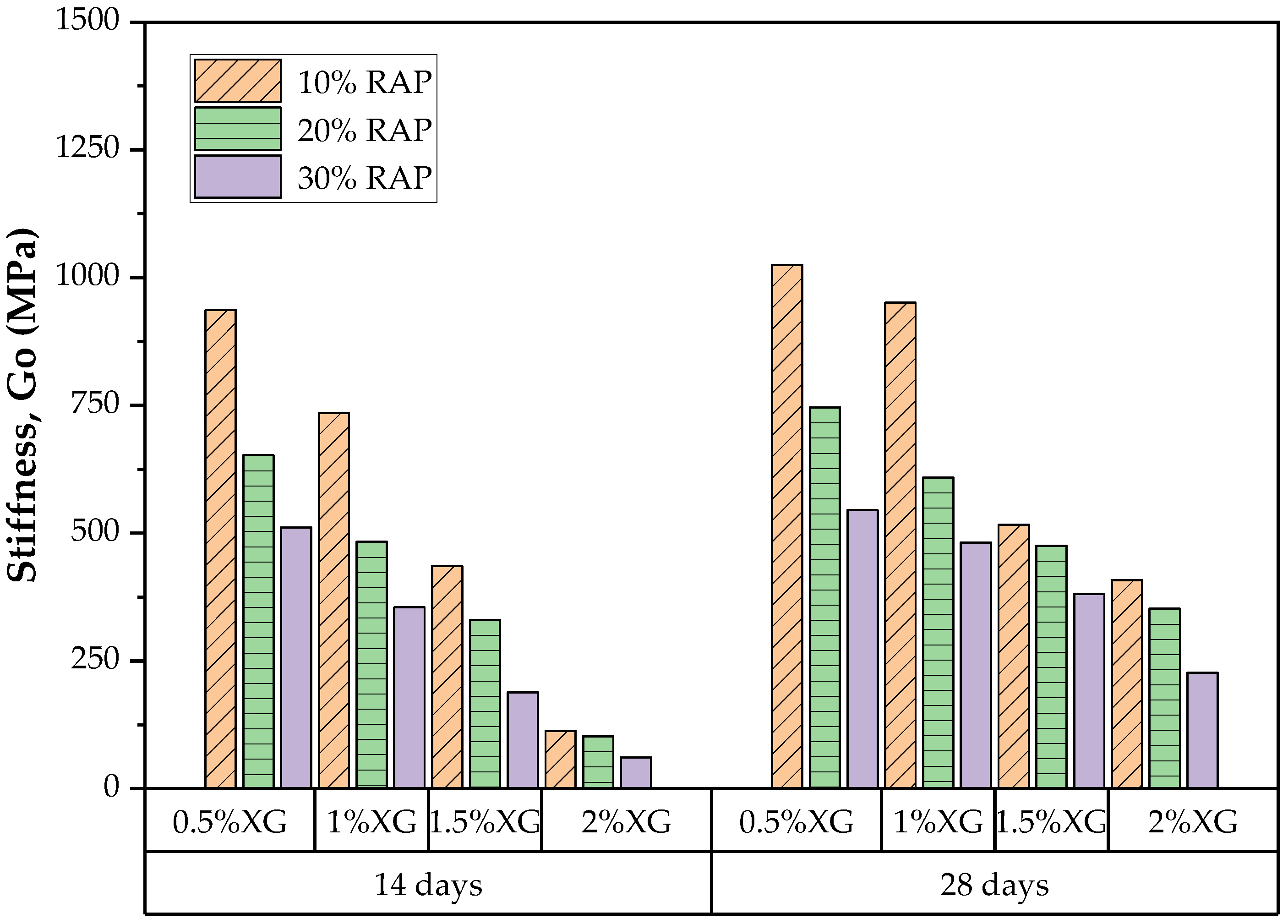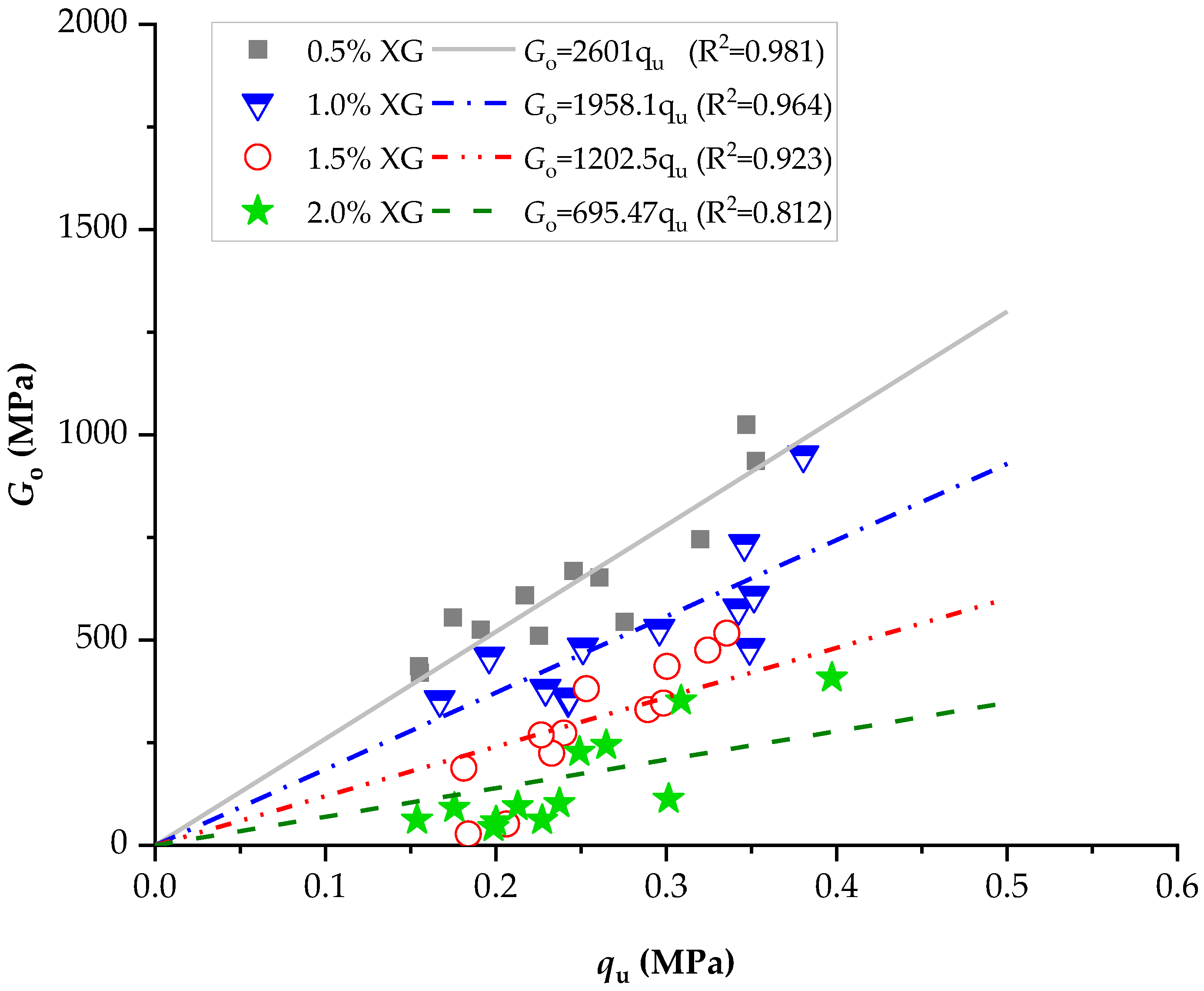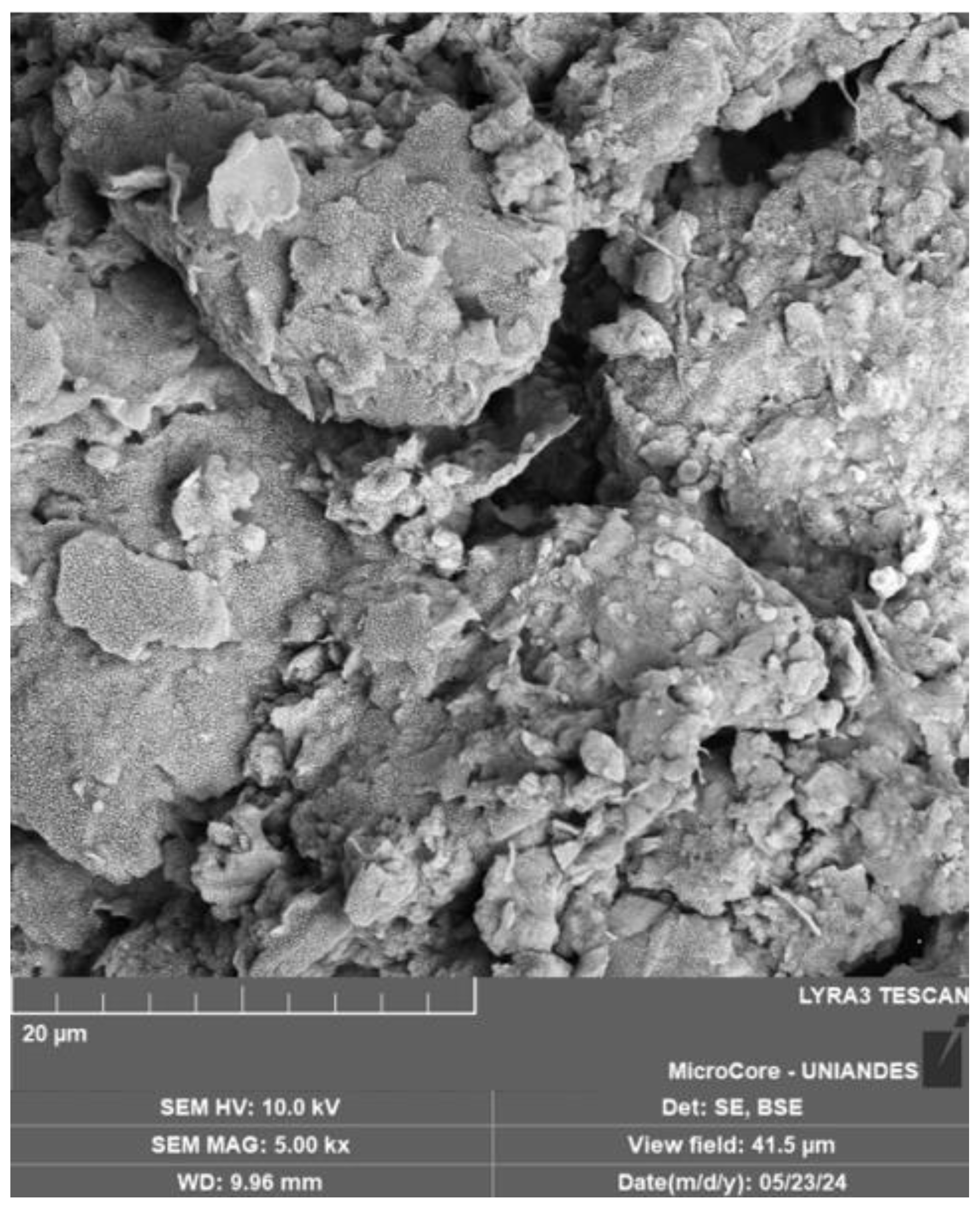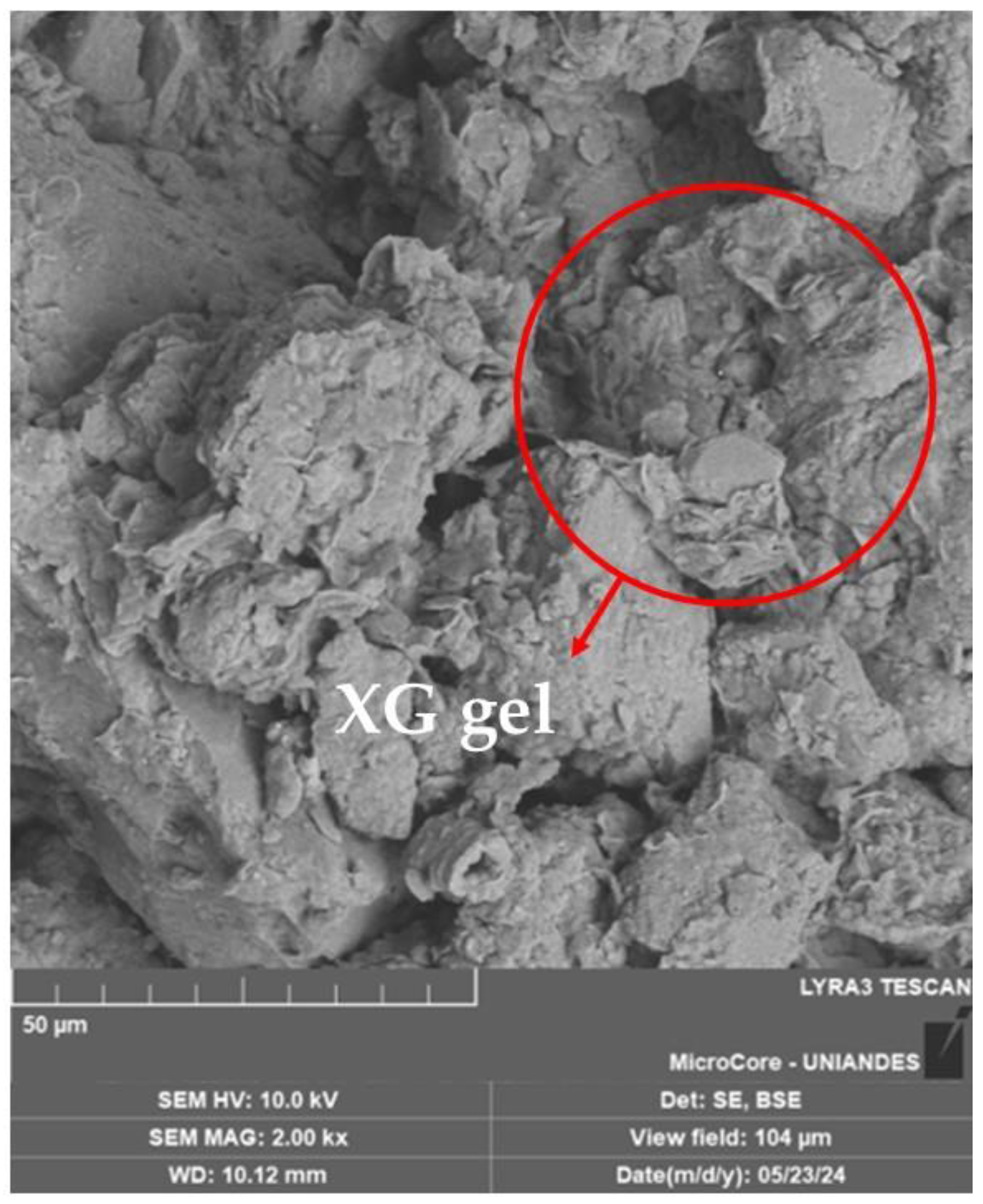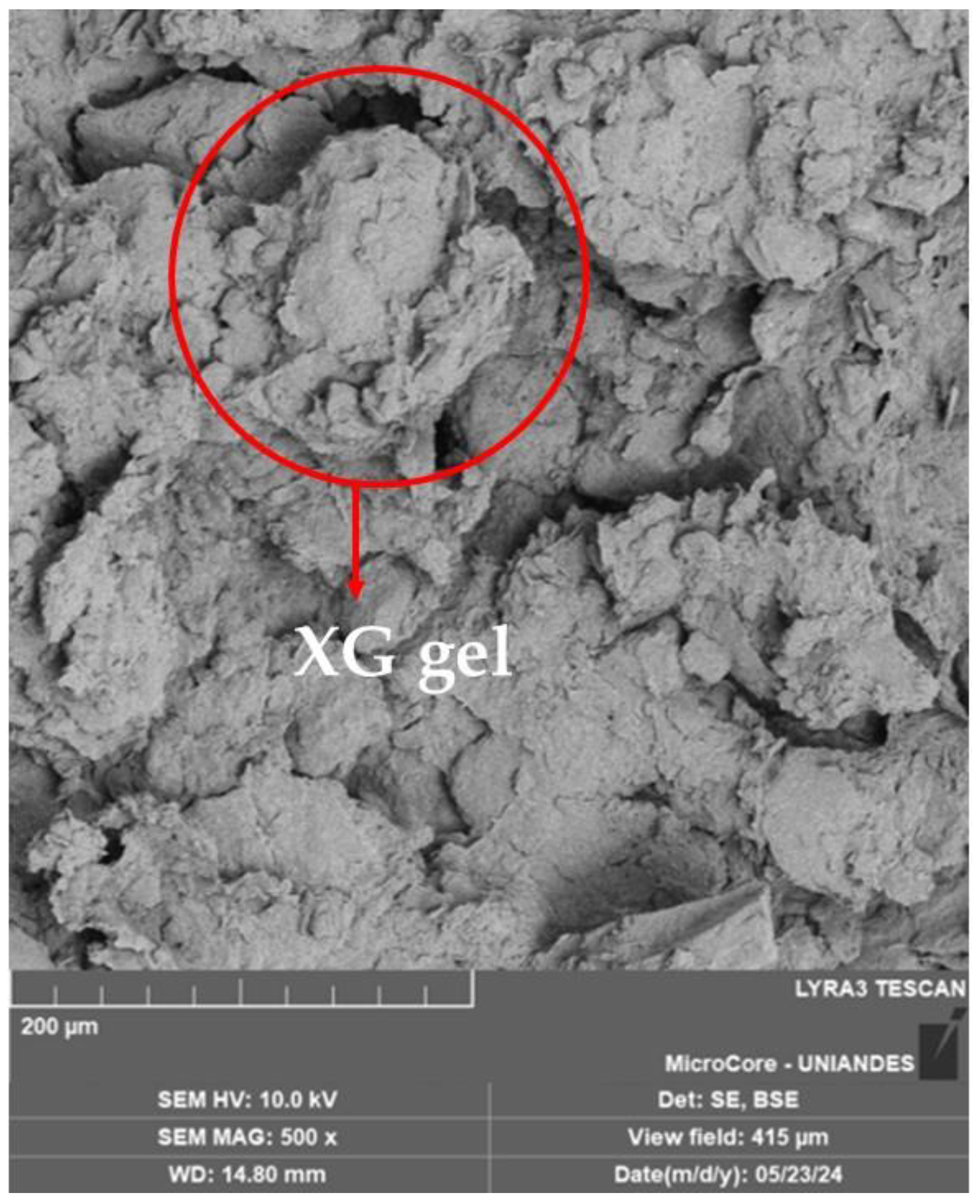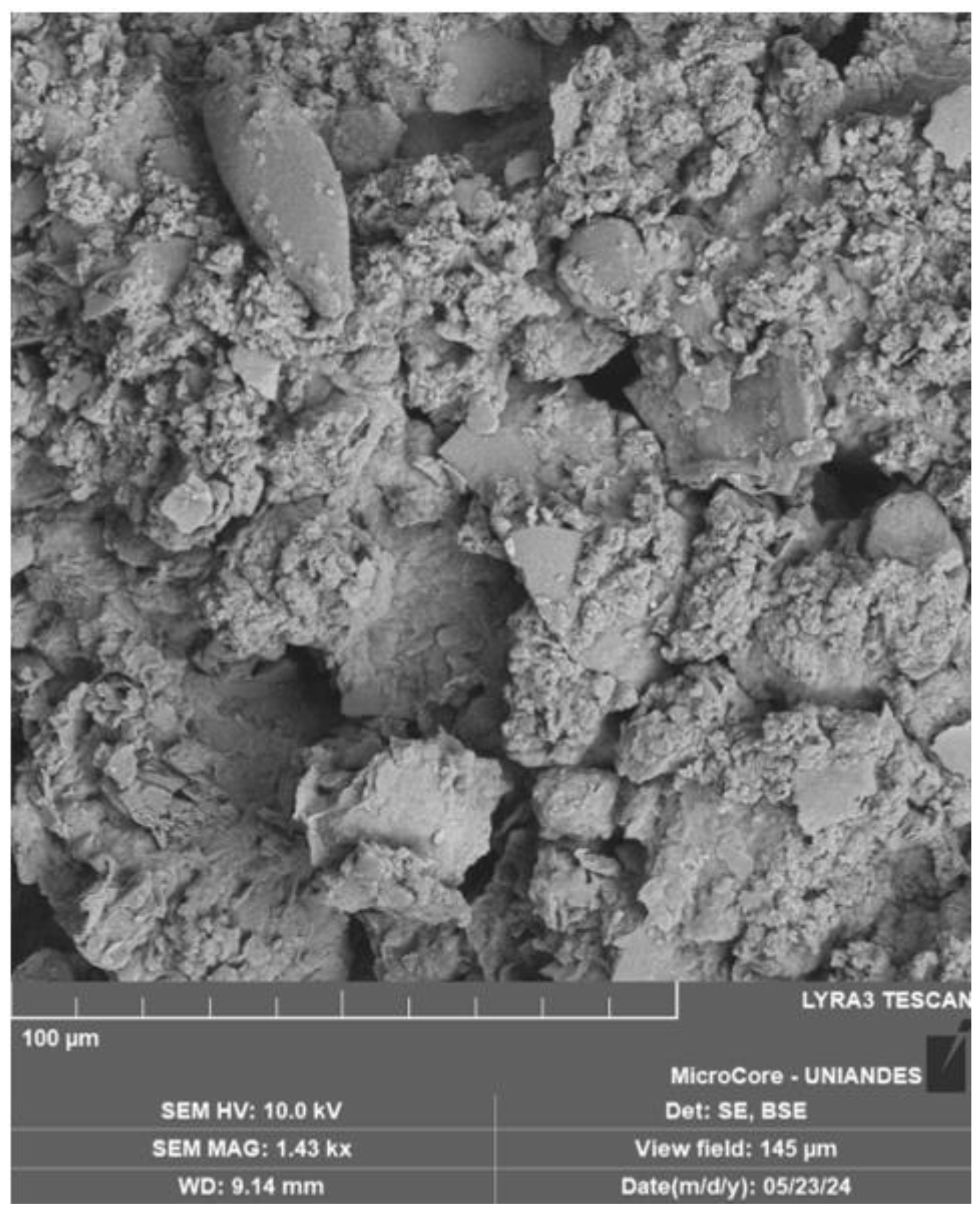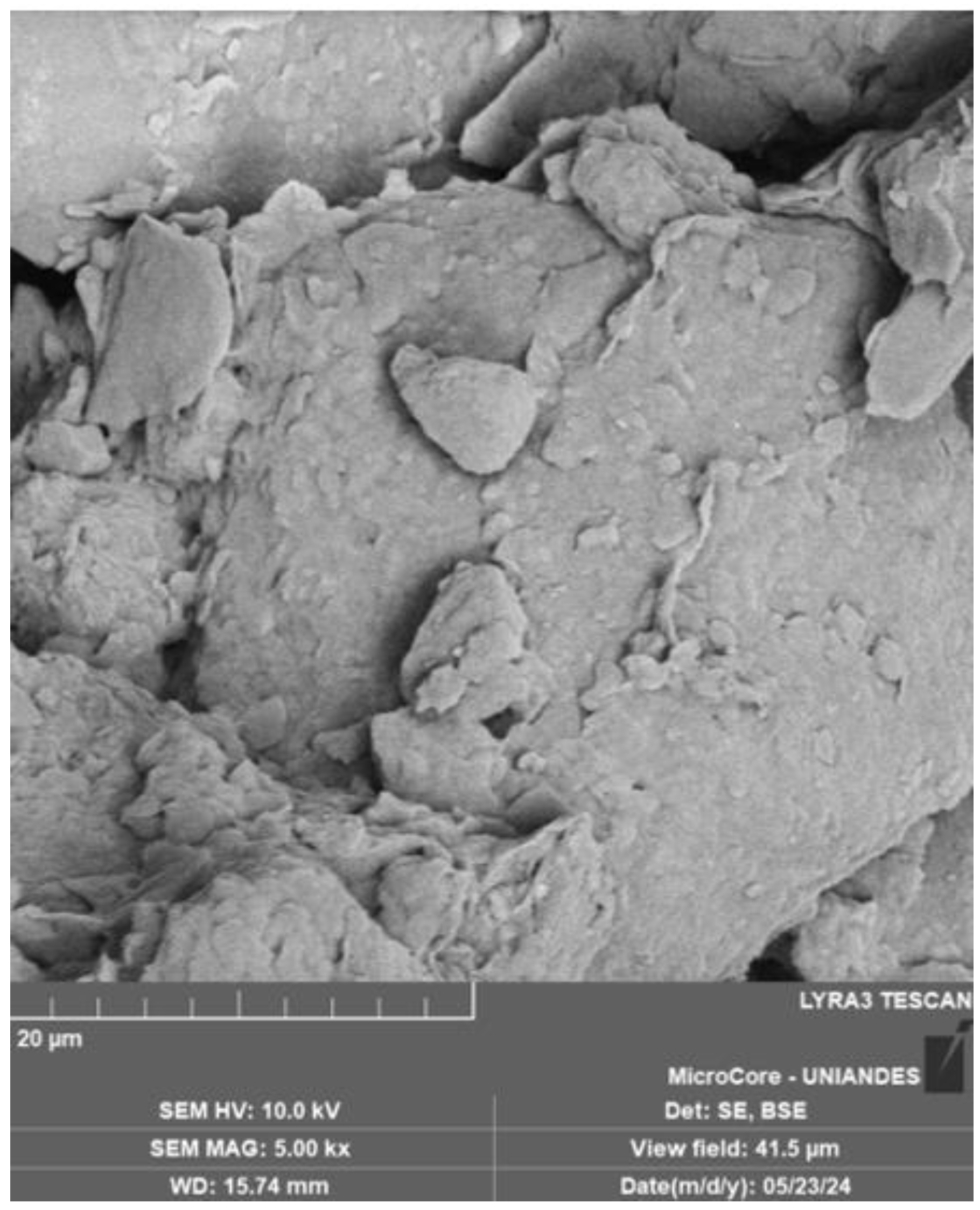1. Introduction
Xanthan gum has been widely recognized as a sustainable and effective soil stabilizer, offering a viable alternative to traditional chemical additives associated with high energy consumption and significant carbon emissions. Numerous studies have demonstrated that incorporating xanthan gum—typically in the range of 0.5% to 2% by dry weight—can dramatically enhance various soils’ physical, mechanical, and microstructural properties. For instance, research on high-plastic clays treated with xanthan gum reported an increase in unconfined compressive strength (UCS) of up to 314%, with strength improvement ratios as high as 8.3 times compared to untreated soils [
1]. Similarly, investigations on kaolinite have shown that a 2% xanthan gum dosage can result in a UCS increase of over 500%, while studies on bentonite revealed improvements of 274–457% after 28 days of curing under optimal conditions [
2,
3].
At the microstructural level, scanning electron microscopy (SEM) and energy-dispersive X-ray spectroscopy (EDS) analyses across multiple studies have consistently revealed that xanthan gum forms a continuous, fibrous network that adheres to soil particle surfaces through bonding interactions. This network effectively fills interparticle voids, reducing porosity and enhancing interparticle cohesion. For example, Ghasemzade et al. [
4] observed that forming such polymeric films in clayey soils significantly improved particle aggregation and reduced permeability. Similar microstructural modifications were reported by Chang et al. [
5] and further confirmed by model experiments conducted on coarse-grained soils, where the optimized xanthan gum treatment not only improved mechanical properties but also led to a more stable soil fabric under dynamic loading [
6,
7].
The dynamic behavior of xanthan gum-stabilized soils under cyclic loading has also been the subject of extensive study. Research by Zhang et al. [
8] indicates that adding xanthan gum, particularly at a dosage of 2% by dry soil mass, can significantly enhance silty soils’ shear strength and structural integrity. These changes are attributed to the robust network structure formed by the biopolymer, which provides enhanced resistance to vibrational loads and minimizes sensitivity to moisture variations. Such improvements are crucial for applications in pavements and slopes, where soils are subjected to repeated traffic loads and environmental fluctuations. The XG hydrophilic and pseudoplastic properties allow it to form resilient biopolymeric networks that improve interparticle bonding, reduce porosity, and lower hydraulic conductivity. This makes treated soils more resistant to moisture fluctuations and cyclic loading, which is critical in transportation infrastructure and slope stability. Furthermore, its biodegradable nature and mechanical reinforcement capacity position gum as a sustainable alternative to conventional chemical stabilizers, especially in scenarios requiring durability and environmental compatibility [
6,
9,
10,
11]. Durability studies have further underscored the promise of xanthan gum in long-term soil stabilization. Experiments involving cyclic wetting–drying and freeze–thaw processes reveal that, although some degradation in strength is inevitable, the optimal dosages of xanthan gum can maintain a substantial portion of the initial strength over multiple cycles. For instance, Minhyeong Lee et al. [
12] demonstrated that soils treated with xanthan gum, particularly at contents of 1% and 2% by dry mass of soil, retained much of their unconfined compressive strength even after severe weathering cycles, notably when the soil contained an appropriate fraction of fines (15–25%).This effect is further enhanced when xanthan gum is combined with other additives, such as biochar, which can mitigate strength loss under freeze–thaw conditions [
13].
In addition to mechanical enhancements, the influence of xanthan gum on the hydraulic properties of soils has been extensively documented. Its hydrophilic nature leads to the formation of hydrated gels that significantly reduce soil permeability by blocking pore spaces. Studies on unsaturated silt and sandy soils have shown that xanthan gum concentrations as low as 0.25% by dry mass can significantly reduce hydraulic conductivity, thereby improving water retention—a characteristic beneficial for slope stability and vegetation support [
3,
14]. In addition, the compressibility and consolidation behavior of soils treated with xanthan gum have been thoroughly examined. Vydehi and Moghal [
15] reported that adding xanthan gum at dosages ranging from 0.5% to 4% by dry weight reduces the coefficient of consolidation (Cv) and modifies the swelling characteristics of expansive soils, with the most significant changes observed at a 2% dosage. These findings suggest that xanthan gum enhances strength and improves long-term settlement behavior, critical for foundation design and pavement performance. Large-scale model experiments have provided practical validation of laboratory findings. Bağrıaçık and Mahmutluoğlu [
16] conducted extensive model tests that demonstrated a bearing capacity improvement of up to 4.47 times and settlement reductions by a factor of 3.5 in clay soils treated with an optimized xanthan gum dosage (approximately 1.75%), mixed at elevated temperatures (around 80 °C) and cured for 42 days. These results highlight the scalability of xanthan gum stabilization techniques and confirm their potential economic and environmental benefits compared to conventional methods.
Xanthan gum significantly enhances soil mechanical properties by forming a robust microstructural network that reduces porosity, improves particle bonding, and modifies dynamic and hydraulic behavior. For example, Muhammad Hamza et al. [
1] found that adding 1.5% xanthan gum to highly plastic clays increased their unconfined compressive strength by up to 314%, while Fateh et al. [
2] and Oliveira and Reis [
3] observed UCS improvements in kaolinite soils reaching between 314% and 500% at dosages around 2%. Dynamic triaxial tests by Zhang et al. [
14] demonstrated that the dynamic shear modulus can increase by 30–50% with higher xanthan gum content—specifically within the range of 1% to 2%—while the damping ratio decreases significantly, indicating a more stable response under cyclic loading. Furthermore, Vydehi and Moghal [
15] found that optimal dosages (around 1–2%) reduce the coefficient of consolidation by up to 40%, thereby altering the consolidation behavior favorably. Large-scale model experiments by Baki Bağrıaçık and Mahmutluoğlu [
6] showed that an optimized xanthan gum treatment (approximately 1.75% dosage, mixed at about 80 °C and cured for 42 days) increased the bearing capacity by 4.47 times and reduced settlement by a factor of 3.5 compared to untreated soils. Microstructural analyses by Chang et al. [
5] and Ghasemzade et al. [
4] consistently revealed that xanthan gum forms a dense, fibrous matrix that bonds soil particles and fills interstitial voids, which enhances water retention and reduces permeability.
Additionally, studies focused on erosion control by Devrani et al. [
17] demonstrated that even minimal xanthan gum application (0.25% solution) can elevate the threshold friction velocity from 20 km/h to 45 km/h, effectively minimizing wind-induced mass loss. Collectively, these findings—supported by detailed mechanical tests, dynamic analyses, and microstructural observations—underscore that xanthan gum not only dramatically increases UCS (by up to 314–500% in various clayey soils) but also enhances dynamic moduli, reduces damping ratios, and improves long-term durability under cyclic environmental conditions. This robust performance, combined with its eco-friendly, biodegradable nature, positions xanthan gum as a highly promising stabilizer for various geotechnical applications [
1,
7,
11,
13,
18,
19,
20,
21,
22,
23].
This study introduces a novel approach to sustainable soil stabilization by integrating reclaimed asphalt pavement (RAP) with xanthan gum in compacted mixtures. While previous studies have examined the isolated effects of biopolymers or recycled materials, limited research has addressed the combined influence of XG and RAP on soil matrices’ geomechanical and microstructural behavior.
Research Motivations and Objectives
The rapid expansion of civil construction and the growing demand for sustainable engineering practices have increased interest in eco-friendly alternatives to conventional chemical stabilizers. Xanthan gum has shown promising results in improving the mechanical behavior of clayey soils; however, its performance in composite geomaterials, such as mixtures of natural soil and reclaimed asphalt pavement (RAP), remains insufficiently explored. This study is driven by the need to reduce traditional stabilization methods’ environmental impact and promote the reuse of waste materials in sustainable geotechnical applications.
Accordingly, the primary objective of this research is to evaluate the effectiveness of xanthan gum in enhancing the mechanical strength, stiffness, and microstructure of compacted soil–RAP mixtures. In addition to this primary goal, the study also seeks to determine the optimal xanthan gum dosage for performance improvement, examine the influence of different RAP contents on the mechanical response, assess the durability of the treated mixtures under varied curing conditions, and investigate the microstructural mechanisms underlying the observed macroscopic behavior through scanning electron microscopy (SEM) and energy-dispersive spectroscopy (EDS) analysis. By addressing these objectives, this work contributes to developing sustainable stabilization strategies for composite geomaterials using biopolymers and recycled materials.
2. Materials and Methods
The experimental procedure began with the collection, preparation, and characterization of the clayey soil, xanthan gum, and reclaimed asphalt pavement. In the sequence, the clayey soil was characterized through a series of tests, including chemical and mineralogical analyses, scanning electron microscopy (SEM–EDS), Atterberg limits determination [
24], grain size distribution [
25], specific gravity measurement [
26], standard Proctor compaction [
27], and visual color evaluation.
The RAP was characterized by assessing its particle size distribution, chemical composition, color, and density.
The xanthan gum was evaluated according to the manufacturer’s specifications, and its fundamental properties—such as density and chemical composition—were also determined in the laboratory. Following the material characterization, the experimental plan was developed. This involved selecting the ratios of soil, RAP, XG, and moisture for mixtures that would be compacted into cylindrical specimens with dimensions of 10 cm in height and 5 cm in diameter. Curing times were set at 14 and 28 days. Each formulation was compacted in triplicate, generating three identical specimens for each mixture. Finally, after the curing period, the samples were subjected to unconfined compression tests, ultrasonic pulse velocity measurements, and scanning electron microscopy (SEM–EDS).
2.1. Materials
Figure 1 shows photos of the raw materials utilized in this study, including the RAP sample, soil sample, and powdered XG. Xanthan gum dissolves in distilled water, the mixing material, as seen in the image of the layered, compacted specimen. The soil employed in the experiments was sourced from the Bayunca Formation, located in the northern sector of Cartagena de Indias. The Bayunca Formation is characterized by sedimentary deposits formed in an intertidal environment, influenced by tidal channels rich in shells and clayey/sandy deposits filling abandoned channels with erosional contacts.
Figure 1 displays a photo of the soil specimen. The RAP waste was extracted from highway pavement repair in the southern Bolívar department, Colombia.
Figure 1 shows the extracted RAP sample.
Table 1 presents the properties of the soil and RAP.
Figure 2 exhibits the granulometric curve of the soil and RAP. The soil sample and RAP exhibit markedly different characteristics that significantly affect their combined behavior in stabilization applications. According to the Unified Soil Classification System SUCS [
28], the soil is categorized as an inorganic clay (CL), featuring a liquid limit of 42% and a plasticity index of 15.9%, which reflects moderate plasticity. Its particle size distribution is dominated by fine-grained fractions—approximately 82% silt, 10% clay, and 8% fine sand—with a minimal mean diameter (d
50 = 0.011 mm) and a specific gravity of 2.80. These properties suggest that the soil has a high capacity for binding and plastic deformation, which is advantageous when interacting with stabilizing agents. The RAP is classified as poorly graded and non-plastic sand (SP). It contains a significant proportion of coarse particles: 30% gravel, 20% coarse sand, 36% medium sand, and 14% fine sand, with no silt or clay present. Its mean particle diameter (d₅₀ = 2.00 mm) is several orders of magnitude larger than the soil’s, and its specific gravity is slightly lower at 2.52. The bitumen content of the RAP is 3.51%, determined in accordance with ASTM D 2172.
Additionally, the RAP’s higher uniformity coefficient (C
u = 10) compared to the soil’s Cu of 7.14 indicates a broader range of particle sizes, albeit with a poorer gradation overall. The contrasting colors—gray for the soil and black for RAP—further emphasize their distinct origins. When these materials are mixed, the fine soil particles can effectively fill the voids between the coarse RAP particles, leading to improved compaction and enhanced mechanical interlocking. This synergy is expected to yield a composite material with superior strength, stiffness, and durability when combined with appropriate stabilizers. Notably, other studies have employed RAP with different gradations; for example, Pasche et al. [
29] studied fiber reinforcement of RAP–powdered rock–cement mixes and used an RAP with 67% gravel and 3% sand and a specific gravity of 2.57. Consoli et al. [
30] investigated the effects of NaCl on the strength of RAP–fly ash–carbide lime mixtures and used an RAP composed of 52% gravel and 48% sand with a specific gravity of 2.51.
The soil sample exhibits typical aggregations found in clay minerals, predominantly illite and kaolinite, as reported by Baldovino et al. [
9], who previously characterized the same soil studied herein. The soil’s chemical composition, expressed as weight percentages, reveals a predominantly siliceous and aluminous material. With SiO
2 accounting for 66.0% and Al
2O
3 for 21.1%, the soil is rich in silicate and aluminosilicate minerals, typical of clayey soils such as illite or kaolinite. Minor constituents such as Fe
2O
3 (0.9%), TiO
2 (0.3%), K
2O (3.1%), and SO
3 (4.0%) further contribute to the soil’s overall mineralogical profile.
2.2. Xanthan Gum Solution Preparation
Xanthan gum was purchased from a local distributor. It is a high-molecular-weight anionic heteropolysaccharide obtained through microbial fermentation. Its primary structure consists of repeating pentasaccharide units composed of two D-glucose residues, two D-mannose residues, and one D-glucuronic acid residue. The main chain comprises a 1 → 4 β-D-glucopyranosyl backbone similar to cellulose, with trisaccharide side chains attached to alternate glucose residues. These side chains contain D-mannopyranosyl and D-glucopyranosyluronic acid units, where the 1 → 2 β-linked D-mannosyl groups bear 6-O-acetyl substituents, and about half of the terminal α-D-mannosyl residues are modified with 4,6-O-(1-carboxyethylidene) substituents.
This complex molecular architecture imparts xanthan gum with distinct rheological properties, such as high viscosity and pseudoplastic behavior, essential for its role in soil stabilization. In engineering applications, XG is typically supplied as a fine white powder with an apparent density ranging from 1.5 to 1.6 g/cm
3, allowing for accurate dosing and uniform distribution during sample preparation. These characteristics, as reported in recent studies (e.g., Chang et al. [
5]; Muhammad Hamza et al. [
1]; Wan et al. [
31], reinforce its suitability as a sustainable and eco-friendly soil stabilizer.
Figure 3 exhibits an SEM image in the BSD (Secondary Electron and Backscattered Electron Detector) of dry xanthan gum particles. The particles exhibit angular and irregular morphologies. An energy-dispersive spectroscopy (EDS) analysis was performed at three points to assess elemental composition. The results indicated average contents of carbon (62.47%), oxygen (29.23%), chlorine (2.48%), sodium (1.98%), and calcium (3.85%).
2.3. Mixing and Compaction Procedures
After characterizing the raw materials, mixtures were produced by combining soil, RAP, xanthan gum, and water in specific proportions. RAP was incorporated at contents of 10%, 20%, and 30%, based on previous studies on RAP stabilization [
32,
33,
34]. The XG was first mixed with water and then added to a dry mixture of soil–RAP. In the present study, 0.5%, 1.0%, 1.5%, and 2.0% XG were used in reference to dry soil. The percentages and process mixing are presented in detail in the flowchart (
Figure 4).
The specimens were produced using a sub-compaction technique, where each blend was statically compacted in three successive layers inside a cylindrical mold measuring 10 cm in height and 5 cm in diameter. The compaction was carried out to achieve target dry unit weights of 17.2 and 18.0 kN/m3, with each blend being prepared in triplicate. Subsequently, the samples were cured for periods of 14 and 28 days.
3. Experimental Program
A comprehensive overview of the experimental plan for the compacted specimens is provided in
Table 2.
The experimental program of study is summarized in
Figure 4. All percentages of RAP and XG are by weight in reference to soil dry mass. As presented in
Figure 5, the compaction curve of RAP and soil was determined through ASTM D698 [
27] and ASTM D1557 [
35]. The RAP was compacted by both standard and modified methods and soil by the standard method. The optimum water content and maximum dry unit weight were calculated. The optimum water content of RAP was measured as 8.5% and 9.7% for modified and standard energy, respectively. The optimum water content of the soil is 18%. RAP’s maximum dry unit weight is 22.8 kN/m
3 and 20.85 kN/m
3 for the modified and standard methods. For soil, the maximum dry unit weight is 17.8 kN/m
3. Because the RAP does not exceed 30%, the dry unit weight of molding for compacted mixtures was chosen as 17 kN/m
3 and 18 kN/m
3. The moisture content of molding was fixed at 18%. No individualized compaction or moisture content–dry unit weight curves were performed for each combination of RAP and xanthan gum content. Instead, a constant water content of 18% was applied to all mixtures, as determined from the optimum moisture content of the natural soil based on the standard Proctor test. This methodological decision, consistent with several previous studies [
9,
36,
37,
38], was made to ensure consistency in the water variable and to isolate the influence of xanthan gum and RAP on both mechanical and microstructural behavior.
3.1. Unconfined Compressive and Stiffness (Non-Destructive) Program
The UCS and Go setup test are illustrated in
Figure 6 and
Figure 7. After 14 and 28 days, the non-destructive ultrasonic test was performed on the soil–RAP–XG specimens in accordance with ASTM C597-02 [
39]. Ultrasonic transducers were positioned at both ends of each specimen to measure wave propagation velocity using the Pundit PL-200 ultrasonic tester (Proseq, Schwezenbach, Swizerland). This measurement was used to evaluate potential cracks or voids, since the stiffness of the compact material is indicated by the maximum wave velocity traversing it—higher velocities reflect a more compact material that deforms less. The degree of deformation can be expressed as the ratio between the specimen’s wet unit weight and the square of the wave velocity. The Pundit PL-200 provides a measurement resolution of 0.1 µs, operates at a pulse voltage between 100 and 450 V, and uses transducers with a nominal frequency of 54 kHz.
The unconfined compressive strength test (UCS) was conducted on each specimen after 14 and 28 days of curing (after ultrasonic non-destructive tests) following ASTM D2166-06 [
40]. Each specimen was placed in a multi-test machine with a load capacity of up to 50 kN and controlled via software, as presented in the schematic in
Figure 6. An axial load was then applied at a constant displacement rate of 1.15 mm/s until failure occurred, and the ultimate load “Q” in kN was recorded to evaluate the unconfined compressive strength of the specimens.
Figure 7.
Test setup of stiffness and unconfined compressive strength [
41].
Figure 7.
Test setup of stiffness and unconfined compressive strength [
41].
3.2. Microstructural Analysis
Following the uniaxial compressive strength (UCS) and non-destructive ultrasonic pulse tests, intact 1 cm³ specimens were carefully extracted from selected samples for microstructural analysis using a the Tescan MicroCore Vega 4 SEM (Brno-Kohoutovice, Czech Republic) at the Microcore Laboratory of Universidad de Los Andes, Colombia. Representative cubes were prepared by precisely cutting the material (see
Figure 7) and subsequently oven-dried at 100 °C for 24 h to remove residual moisture while preserving microstructural integrity. After drying, specimens were mounted on aluminum stubs with conductive carbon tape and, when necessary, coated with a thin layer of gold to enhance surface conductivity and imaging quality. SEM imaging was conducted at an acceleration voltage of 15–20 kV, utilizing both secondary and backscattered electron detectors to capture high-resolution morphological details. Simultaneously, real-time energy-dispersive X-ray spectroscopy (EDS) analysis was used to determine the elemental composition across various regions of interest, with instrument settings optimized to achieve a resolution of approximately 0.1 µm. This integrated SEM–EDS approach enabled detailed examination of microstructural characteristics and elemental distribution in the stabilized soil–cement–latex–CLW mixtures, offering valuable insights into the interfacial bonding between binder and aggregate phases.
4. Results and Discussions
4.1. Effects of Xanthan Gum on the Unconfined Compressive Strength of Soil–RAP Compacted Mixtures
The unconfined compressive strength results for specimens molded at dry unit weights of 17.2 kN/m
3 and 18 kN/m³ are shown in
Figure 8 and
Figure 9, respectively. The plotted data correspond to the average of three identical specimens. The results indicate several trends regarding the unconfined compressive strength (q
u) of soil–RAP mixtures stabilized with varying xanthan gum dosages and subjected to different curing times (14 and 28 days). First, an extended curing period (28 days) yields higher q
u values than specimens cured for only 14 days. For instance, when 10% RAP is combined with 1% XG in the soil, the q
u at 14 days ranges from approximately 296 to 345 kPa, whereas at 28 days, it increases to 342–380 kPa. This outcome underscores the role of curing time in fostering the development of the biopolymer network, which effectively enhances the matrix formed by the soil, RAP particles, and XG.
The proportion of RAP significantly affects mechanical performance. Specimens containing 10% RAP consistently achieve higher qu values than those with 20% or 30% RAP. At 14 days and 1% XG, qu for the 10% RAP mixture is about 345–296 kPa, whereas at 20% and 30% RAP, qu decreases to roughly 251–196 kPa and 242–167 kPa, respectively. A similar pattern persists at 28 days, with 10% RAP mixtures achieving strengths as high as 380–342 kPa, while 20% and 30% RAP exhibit lower strengths (in the vicinity of 350–230 kPa). This observation suggests that a higher RAP content can introduce larger voids and reduce the homogeneity of the stabilization matrix, thus hindering strength development.
Among the four XG dosages evaluated (0.5%, 1.0%, 1.5%, and 2.0%), 1% XG appears to be the most consistently effective in enhancing qu. At 14 days, for example, the 10% RAP mixture with 1% XG reaches qu values exceeding 300 kPa, while 1.5% and 2.0% XG often exhibit somewhat lower or more variable results (e.g., 300–240 kPa for 1.5% XG and 10% RAP). At 28 days, the exact dosage of 1% XG continues to provide strong performance, reaching 380 kPa in some instances. Although 2.0% XG can occasionally produce notably high qu values (e.g., 397 kPa with 10% RAP), it also demonstrates a higher degree of variability, suggesting potential issues with oversaturation or uneven polymer distribution.
According to ASTM D4609 [
42], an unconfined compressive strength (UCS) of 345 kPa is the minimum limit for adequate field strength in soil stabilization. An analysis of the experimental data reveals that, at a 14-day curing period, only a few replicates in the 10% RAP mixtures stabilized with 0.5% and 1.0% xanthan gum marginally exceed this threshold—one replicate at 10% RAP and 0.5% XG achieves approximately 352 kPa, and one replicate at 10% RAP with 1.0% XG reaches around 346 kPa. In contrast, mixtures with 20% and 30% RAP consistently fall below 345 kPa at 14 days across all xanthan gum dosages. Extending the curing period to 28 days generally enhances strength; however, even then, only the 10% RAP mixtures demonstrate the potential to meet or exceed the ASTM threshold. For instance, at 28 days with 1.0% XG, one replicate of the 10% RAP mix reaches 380 kPa, and with 2.0% XG, one replicate achieves 397 kPa, whereas the corresponding replicates at higher RAP percentages remain below 345 kPa. These results suggest that the optimal mix for meeting the ASTM D4609 requirement is a soil–RAP mixture containing 10% RAP combined with an XG dosage of approximately 1.0–2.0%, provided that sufficient curing time (28 days) is allowed for the entire biopolymer interaction and matrix development. The q
u results were plotted for 14 and 28 days to determine the average increase with the curing time, as shown in
Figure 10. The measured values at 28 days were 20% higher than those at 14 days, corresponding to an average increase of 1.20 times.
A comparative analysis of the results reported in the present study by Wan et al. [
21] and those documented in the literature reveal that xanthan gum, when incorporated at dosages ranging from 0.5% to 2.0%, substantially enhances the unconfined compressive strength (UCS) of stabilized soils. In the present investigation, an optimal dosage of 1.0% xanthan gum combined with 10% reclaimed asphalt pavement (RAP) and a curing period of 14 to 28 days yields a maximum UCS of approximately 380 kPa. This outcome is consistent with findings reported by Fateh et al. [
2], who demonstrated that a 1% xanthan gum dosage significantly improves soil performance under freeze–thaw conditions. Similarly, Hamza et al. [
1] observed that incorporating 1.5% xanthan gum in high-plastic clays increased UCS by up to 314% relative to untreated soils after extended curing periods of up to 60 days, indicating a pronounced reinforcement effect. In contrast, model experiments by Bağrıaçık and Mahmutluoğlu [
6] on coarse-grained soils identified an optimum xanthan gum dosage of 1.75%, suggesting that the ideal dosage may vary with soil gradation and RAP content. Collectively, these studies suggest that although the optimal xanthan gum dosage is contingent upon specific soil characteristics and treatment conditions, the results of the present study confirm that a 1.0% dosage is highly effective for clay–RAP mixtures, achieving compressive strengths that are competitive with or superior to those reported in previous investigations. However, the effectiveness of xanthan gum varies in the literature depending on material properties and curing conditions.
4.2. Effects of Xanthan Gum on the Stiffness of Soil–RAP Compacted Mixtures
Figure 11 and
Figure 12 illustrate how the stiffness parameter (Go) in soil–RAP–XG mixtures is significantly influenced by RAP content, xanthan gum dosage, curing duration, and target dry unit weight. The stiffness results (Go) of the soil–RAP mixtures stabilized with xanthan gum display several notable patterns when comparing different RAP contents, XG dosages, and curing times (14 vs. 28 days).
Figure 11 and
Figure 12 show that extending the curing period from 14 to 28 days consistently yields higher stiffness values across most mixtures, a finding that aligns with the general expectation that additional curing allows the biopolymer matrix to develop more fully. For instance, at 10% RAP and 0.5% XG, the stiffness increases from 937 MPa (one replicate reaching 556 MPa in the second measurement) at 14 days to a peak of approximately 1.025 MPa at 28 days—an indication that the xanthan gum network continues to consolidate over time.
The percentage of RAP has a pronounced effect on stiffness. Mixtures containing 10% RAP typically achieve the highest Go values. At 28 days and 0.5% XG, for example, one replicate reaches 1.025 MPa, whereas 20% and 30% RAP produce maximums of 746–609 MPa and 545–526 MPa, respectively. This outcome suggests that a low RAP content (around 10%) strikes a balance between providing coarse particles for mechanical interlock and avoiding excessive void space, which can diminish stiffness if not adequately filled by the soil or stabilized by the biopolymer.
The XG dosage emerges as a key determinant of stiffness. Although 1% XG sometimes produces stiffness values comparable to or exceeding those observed at 0.5% XG (e.g., 951 MPa at 28 days with 10% RAP), 1.5% and 2.0% XG typically yield considerably lower Go values and exhibit more significant variability. This phenomenon indicates that while small to moderate XG contents help form a robust polymer network, higher dosages may lead to localized flocculation or uneven distribution, thereby reducing the overall uniformity of the composite.
Figure 13 presents the incremental unconfined compressive of 28 days of curing with 14 days. On average, the incremental of Go is 19%.
Figure 13 presents the average incremental increase in initial stiffness (Go) observed after 28 days of curing relative to the values at 14 days.
Figure 13 synthesizes the average trend of stiffness improvement observed across all tested mixtures. On average, the increase in Go was approximately 19%, confirming the positive effect of extended curing on the development of the biopolymer network.
4.3. Relationship Between Stiffness and Unconfined Compressive Strength
Analysis of the compacted soil–RAP–XG mixtures showed a linear correlation between the unconfined compressive strength (q
u) and the stiffness parameter (Go), based on combined data from both 14- and 28-day curing periods. The equation to 0.5% XG can express:
Go = 2601q
u (
R2 = 0.981), for 1.0%XG the equation is
Go = 1958.1q
u (
R2 = 0.964), for 1.5%XG the equation is
Go = 1202.5q
u (
R2 = 0.923), and for 2.0%XG the equation is
Go = 695.45q
u (
R2 = 0.812). The direct relationships are designed in
Figure 14.
Table 3 summarizes the direct relationship between the stiffness (Go) and strength (UCS) of various compacted geomaterial mixtures as reported in the literature. The newly derived relationships between unconfined compressive strength (q
u) and small strain stiffness (Go) for the present soil–RAP–XG mixtures show a clear trend of decreasing slope (i.e., lower qu/Go ratio) as the XG dosage increases from 0.5% to 2.0%. Specifically, when 0.5% XG is employed, the best-fit equation suggests q
u = 2601Go with an
R² of 0.98, whereas at 1.0% XG, q
u = 1958.1Go (
R² = 0.96). This ratio diminishes further at 1.5% and 2.0% XG, yielding q
u = 1202.5Go (
R² = 0.92) and q
u = 695.47Go (
R² = 0.81), respectively. Such a progressive reduction in the qu/G
o coefficient indicates that as more biopolymer is added, the relative gain in stiffness outpaces the corresponding increase in compressive strength, leading to a lower overall ratio.
Comparing these findings with the references for other compacted geomaterials highlights similarities and distinctions in how qu and G
o correlate. In certain studies involving cementitious binders, such as sand–cement studied by Lopez et al. [
44] (q
u = 7465.9G
o,
R2 = 0.86) or clayey soil–cement–CLW studied by Roman et al. [
43] (q
u = 4828.8G
o,
R2 = 0.96), the q
u/G
o ratio is substantially higher. This disparity may be attributed to the strong cement hydration reactions that yield a denser and more rigid matrix, resulting in comparatively larger compressive strength for a given stiffness. By contrast, clayey soil–xanthan gum (q
u = 1915.3G
o,
R2 = 0.98) aligns more closely with the present study’s 0.5–1.0% XG results, suggesting that xanthan gum in moderate dosages exhibits a qu/G
o ratio akin to other non-cementitious stabilizers.
Further complexity arises from those references employing non-linear functions (e.g., qu = 0.00124Go1.73 or qu = 1 × 10−5Go2.3055), indicating that specific stabilizers or soil conditions generate a power law relationship rather than a linear one. Nonetheless, the R² values across all cited linear and non-linear relationships remain consistently high, underscoring a strong correlation between stiffness and compressive strength once the soil–binder matrix is fully developed.
The present study’s q
u = a·Go (a constant) relationships confirm that xanthan gum dosage critically influences how stiffness and compressive strength evolve. While low to moderate XG contents (0.5–1.0%) yield relatively higher q
u/Go ratios, heavier dosages produce more stiffness than compressive strength, reducing that ratio. When contrasted with cement-based or alternative stabilizers, xanthan gum exhibits a distinct mechanical signature that can be advantageous for specific geotechnical applications where high stiffness and moderate strength are required in an environmentally friendly framework. Recent studies have reinforced the relevance of biopolymers like xanthan gum for geotechnical applications involving recycled or problematic materials. For instance, incorporating biopolymer-based additives has improved stabilized soils’ mechanical behavior, durability, and hydraulic properties under environmental loading conditions, such as wetting–drying and freeze–thaw cycles [
52,
53,
54].
4.4. Microstructure of Compacted Mixtures
A comprehensive microstructural evaluation of the compacted soil–RAP–XG mixtures was carried out using scanning electron microscopy (SEM–EDS). This technique allowed for high-magnification imaging that provided an in-depth understanding of the internal structure and composition of the specimens. The analysis revealed critical information regarding the interactions among the soil, RAP, and XG, including forming a cohesive matrix, developing binder films, and distributing key elemental constituents. Specific morphological features—such as well-bonded interfaces between particles, homogeneous dispersion of the RAP, and the integrity of the XG coatings—were identified, offering a solid basis for explaining the mechanical behavior and durability of the mixtures under varying environmental and loading conditions.
Analyzing the results obtained via SEM–EDS reveals an exceptional level of microstructural detail, with image magnifications reaching up to 5000×—far exceeding conventional observations [
1,
5]. For instance,
Figure 15 corresponds to the microanalysis of a mix comprising 10% RAP, 0.5% xanthan gum, and a compaction density of 18.0 kN/m³ after 14 days of curing. In this highly magnified image, remnants of xanthan gum are distinctly observed within the fine soil matrix, forming a physical bond without evident chemical reaction; this bond is mainly responsible for the improved mechanical performance, as the agglomerated structure reflects the high compaction level applied. In contrast,
Figure 16, magnified 1560×, illustrates the detailed morphology of reclaimed asphalt pavement (RAP) particles within a mix containing 20% RAP and 1% xanthan gum (18.0 kN/m³, 14-day cure). Here, RAP particles interact with the fine soil–xanthan gum matrix, yet they remain chemically inert, serving as a stable filler.
Furthermore,
Figure 17, at 2000× magnification, displays the microstructure of a mix with 30% RAP and 2% xanthan gum at 18.0 kN/m³ after 14 days, where a continuous network of xanthan gum and RAP is visible, although cracks or voids appear—likely due to the relatively lower dry unit weight contributing to less homogeneous compaction. Shifting to the 28-day cured samples,
Figure 18 (500× magnification) for the 10% RAP–0.5% xanthan gum mix at a slightly reduced compaction density of 17.2 kN/m
3 shows distinct regions of xanthan gum remnants alongside RAP particles, with voids corresponding to the applied density. Similarly,
Figure 19 (1430× magnification) for the 20% RAP–1% xanthan gum mix at 17.2 kN/m³ reveals that the xanthan gum disperses throughout the fine soil matrix, creating voids that are beneficial for enhancing soil support and displaying RAP particles in the upper right section. Finally,
Figure 20, magnified 5000×, presents the 30% RAP–2% xanthan gum mix at 17.2 kN/m
3, where xanthan gum appears as discrete clumps amid RAP particles. Due to the compaction method and lower density, this clumping highlights the robust cohesion and rigid bonding achieved via favorable chemical interactions within the mix.
These microstructural observations corroborate the findings of previous studies, which have demonstrated that xanthan gum can effectively enhance soil stabilization by forming a dense, fibrous network that improves interparticle bonding and reduces porosity [
6,
16,
55]. The detailed SEM–EDS analyses provide valuable insight into how xanthan gum contributes to the mechanical resilience and durability of soil–RAP composites under varying compaction and curing conditions.
SEM–EDS was conducted in
Figure 19. Three specific points were selected for energy-dispersive spectroscopy analysis to elucidate the chemical characteristics of the composite. Consequently, the chemical composition at these locations is detailed in the subsequent spectra. Spectra 4, 5, and 6 reveal the elemental distribution within the mixture, highlighting the dominant phases present in the fine soil, RAP, and xanthan gum. In Spectrum 4, the marked presence of oxides—key constituents of the fine soil—underscores the mineralogical foundation of the matrix when combined with RAP and xanthan gum. Spectrum 5 exhibits prominent peaks for silicon (Si) and oxygen (O), which together indicate the formation of silica (SiO₂) and suggest the development of a delicate silica membrane as a result of chemical interactions between the xanthan gum and the fine soil. Finally, Spectrum 6 shows that oxygen (O) is the predominant element, reflecting a high concentration of oxides that confirms the influence of fine soil in the overall composition. The xanthan gum interacts with the aged bitumen in RAP through weak hydrogen bonds. These occur between polar groups in some bitumen proportions and functional groups in the xanthan. The gum forms a gel-like matrix that fills voids and binds particles together, improving cohesion and reducing porosity. These detailed spectral analyses, which align with findings reported in previous studies [
2], provide crucial insights into the microstructural interactions and chemical processes that underpin the enhanced performance of xanthan gum-stabilized soil composites.
Figure 21 presents the SEM micrograph of the compacted mix containing 10% RAP and 1% xanthan gum, which is identified as the optimal formulation for strength and stiffness. The microstructure shows a dense and cohesive matrix, where the xanthan gum forms a continuous network that bridges fine soil particles and partially encapsulates the RAP grains. This configuration enhances interparticle bonding and reduces voids, contributing to the improved mechanical performance observed in UCS and stiffness tests.
Table 4 provides a comparative overview of selected recent studies involving xanthan gum as a soil stabilizer, including cases with and without RAP incorporation. Most prior works focused either on natural fine-grained soils or coarse aggregates, with mechanical evaluation typically limited to UCS testing. At the same time, some studies demonstrated strength improvements with varying XG contents and curing durations, and a few integrated reclaimed materials or microstructural analyses. In contrast, the present study offers a combined approach by incorporating 10% RAP and systematically varying XG dosages while performing SEM–EDS imaging and establishing q
u–G
o correlations.
5. Conclusions
Based on the experimental results and analyses, the following conclusions were drawn:
The optimal mixture for enhancing compressive strength and initial stiffness consisted of 10% RAP and 1.0% xanthan gum, compacted to 18 kN/m3 and cured for 14 days. Under these conditions, the UCS reached 380 kPa, and the initial stiffness (Go) exceeded 1000 MPa. Extending the curing period to 28 days increased UCS by approximately 20%, indicating the progressive development of the biopolymeric network.
The incorporation of 10% RAP improved the strength of the soil mixtures, while xanthan gum up to 1.0% further enhanced both the UCS and stiffness. Higher dosages (1.5% and 2.0%) decreased strength, likely due to polymer oversaturation and agglomeration effects.
SEM–EDS analyses confirmed that xanthan gum forms a continuous network that bonds soil particles and fills voids between RAP grains, improving interparticle contact and reducing porosity. However, RAP contents above 10% increased heterogeneity and void formation, negatively affecting performance.
A strong linear correlation was found between the UCS and initial stiffness (Go), with regression coefficients above 0.81. Notably, the qu/Go ratio decreased as XG content increased, suggesting that higher xanthan gum dosages contribute more significantly to stiffness development than to compressive strength.
These findings demonstrate the effectiveness of xanthan gum as a sustainable stabilizer for soil–RAP mixtures and provide a guide for optimizing biopolymer dosage and curing conditions in geotechnical applications.

